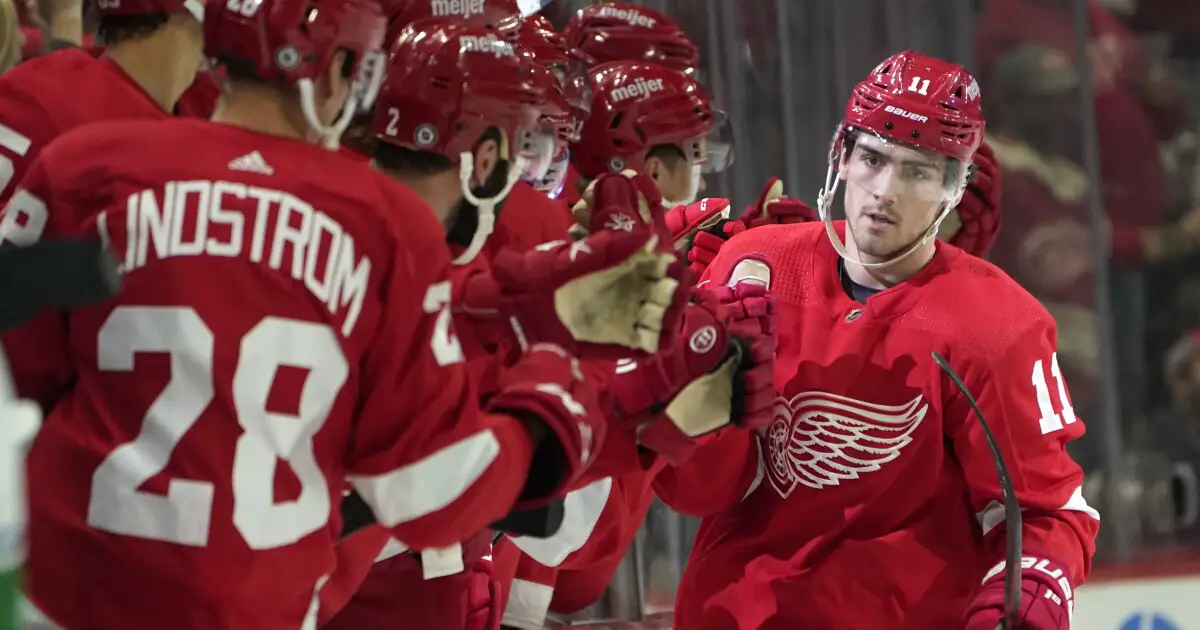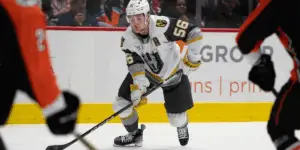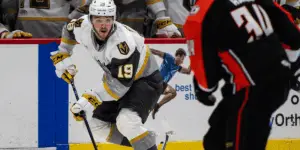
It seems like every other week this season that there is a new discourse on the play of Filip Zadina. The newest comes in response to Jeff Blashill scratching the 2018 6th overall pick Tuesday versus San Jose. Zadina’s 21-22 season has been anything but productive, with four goals and 10 points in 32 games. This begs the question, what’s going on with the highly skilled winger?
When called up in the 19-20′ season, Zadina was one of the best Red Wings forwards as a 19-year-old and recorded 15 points in 28 games which is a 44 point pace if he would’ve played an entire season. He became a powerplay threat as he had 7 of his points on the man-advantage, which is his bread and butter. Since the 19-20′ season Zadina has played 81 games and has had 29 points and only ten goals, far removed from the pace of half-a-point per game. The 20-21′ season was hard on Zadina and slowed down his development. He was relied on to drive offense in a top-six role with players who weren’t to that level while also needing to play a solid two-way game, which he was able to do.
This Season
This season, Filip Zadina has been a great example of analytics versus counting stats. On the surface, Zadina ranks 11th on the Red Wings in points. The points haven’t exactly translated to the NHL for a guy who was billed as this highly offensive winger out of the QMJHL.
Analysis of Zadina has been one of the Red Wings’ best forwards in generating offense. From Natural Stat Trick, Zadina is first among Red Wings’ forwards in SF% with 50.59% and second on the team in xGF% with 51.87%. While Zadina is on the ice, the Red Wings have more shots for than against and, with that, are generating more dangerous chances. But when you look at his GF%, Zadina is 5th from the bottom at 37.04%. Zadina is struggling to capitalize on his chances, and the team is getting scored on more when he is on the ice.
This play right here stands out to me as he has a breakaway with plenty of time but instead takes a quick shot that doesn’t leave the ice. Zadina has shown over the past two seasons that he is a confidence-driven player. When he is consistently on the scoresheet, Zadina has unmatched confidence. When he is in a slump which has been a large part of this season, he is visibly angry when he doesn’t score and seems to lack the ability to move on from a situation such as not scoring.
Lineup Positioning
Zadina’s lack of scoring and bouncing around from lines 2 through 4 has led to Zadina really struggling to find his role on this team. The second line was arguably generating the most chances early into the season, but with little luck with pucks actually going into the net. As guys like Tyler Bertuzzi and Dylan Larkin were out of the lineup for stretches, there was lots of juggling in the lineup, and Zadina couldn’t adjust.
2nd line
Coming into this season, I was optimistic about Zadina and thought the addition of Pius Suter and a healthy Robby Fabbri would lead to a productive second line. Early on, the trio was able to generate a lot of offensive chances but little production. Through the first ten games, here is how the second line produced individually:
Filip Zadina: 10GP 2G 3A 5PTS
Pius Suter: 10GP 1G 0A 1PTS
Robby Fabbri: 10GP 2G 3A 5PTS*
The asterisk next to Fabbri is because 4 out of those 5 points came when Fabbri filled in on the top line. It’s hard to imagine a winning formula with that production from your second line. While Zadina was producing at a respectable rate through his first 10, he went cold his next eight games with only one assist. The other two members of the line started to heat up and produce to their capabilities. This led Jeff Blashill to switch Zadina with Givani Smith, as he wanted more size on that second line.
3rd line
In a move to attempt to generate more offense from Zadina, Blashill placed Zadina with Michael Rasmussen and Adam Erne. The logic is there as Erne and Rasmussen are bigger bodies making more space for Zadina to generate offense. But with the style that Erne and Rasmussen play, Zadina often wasn’t getting the puck back.
There was a glimmer of hope that the line would work out as Zadina would register seven shots on goal in back-to-back games. Especially in the December 14th game versus the New York Islanders, Zadina was actively getting into dangerous areas for scoring chances. Unfortunately, he could not get on the scoresheet, which has been his luck this year.
4th line
Skating on Thursday before the game versus Anaheim was pushed back until Sunday in the morning. This initial switch happened on November 16th versus Dallas in a switch of Givani Smith and Filip Zadina. Zadina was slotted in to play on the 4th line after being scratched versus San Jose. Playing with Sam Gagner and Carter Rowney, Zadina actually scored in this game and looked as if this move was a wake-up call. Sam Gagner is a brilliant hockey player and was able to find Zadina in different areas of the ice for quality chances. Zadina could generate more chances against opposing teams’ bottom-six as he had more time and space.
While Zadina has been able to play well on the 4th line, it’s not a place in the lineup a recent 6th overall pick should be in. Cutting Zadina’s even-strength and powerplay time only further hurts the production issue that has plagued him all season.
What To Do With Filip Zadina
Put him in a position to succeed
While sending a message to a young player by scratching him or cutting his ice-time for a game or two is common practice, it is not a full-season solution. This season, Zadina hasn’t been able to produce with Robby Fabbri or Pius Suter consistently, and they are playing well on the second line of late. A line that could make sense, for the time being, would be Namestnikov-Veleno-Zadina. This line has just about every element you can ask for skill, speed, and some grittiness. Namestnikov has been the best player in the Red Wings’ bottom-six, and playing him with two young players who haven’t exactly found their roles this season but have a lot of talent could pay off nicely.
Another factor to Zadina finding his game would be the return of Jakub Vrana to the lineup. Jakub Vrana underwent shoulder surgery near the end of September and is on track to return to action around the beginning of February. In the short amount of time that Zadina and Vrana have played together, they developed chemistry and were the Red Wings’ best forwards down the stretch of last season.
Zadina is one of Detroit’s best powerplay weapons and has, for the most part, been expected to carry the second unit most of the year. The Red Wings have tried stacking the first unit for most of the season, which has led to the Red Wings having the second-worst powerplay in the entire NHL at 14%. Zadina has only two powerplay goals as the second unit has had issues setting up in the offensive zone and retrieving loose pucks, which has led to Zadina having the puck less.
Having this setup gives the Red Wings two close to equal units and a designated guy to run it through. Zadina would have Bertuzzi down low, one of the league’s best players at puck retrievals. Seider has proven to be a productive powerplay quarterback and has a natural ability to keep pucks in the zone. He also set up Zadina on both of his powerplay goals, including this snipe.
Trade?
Trading a player like Zadina is a risky move as he is still only 22 years old, and his value is not at his highest currently. With trading a former top-10 pick like Zadina as a rebuilding team like Detroit, you want to get in return a high-end proven NHL player who can help you now and in your future. A young player for young player trade has the chance to backfire and hurt you in the long run as you are dealing with potential, for example, the Robby Fabbri trade for St. Louis. Trading for a young high-end NHL is hard to come by and isn’t cheap. Also, they’d be receiving young players or picks who they are hoping for potential, which also has risk. A team like Detroit has plenty of quality prospects, and draft picks to make a deal worth a team’s time.
Jakob Chychrun
Jakob Chychrun makes a lot of sense for the Red Wings. He’s only 23 years old (24 in March) and plays a strong two-way game which Steve Yzerman looks for in a defenseman. Sportsnet’s Elliotte Friedman reported a few weeks ago that the Coyotes were shopping Chychrun and were looking for a return similar to the Jack Eichel trade. The Coyotes are positioned to be in a rebuild for the long haul. Trading a valuable piece like Chychrun, who will be in his later twenties when the team is competitive, could help accelerate the process.
The Red Wings traded down in the draft to unload Pavel Datsyuk’s cap hit as he returned to Russia and received the 20th and the 53rd overall pick in the draft. Essentially, the trade was Jakob Chychrun for Dennis Cholowski and Filip Hronek from a player’s perspective. Chychrun was drafted 16th overall in the 2016 draft, which, funny enough, was actually Detroit’s pick. While Hronek is a top-four defenseman in Detroit, he’s not Chychrun caliber.
Chychrun had a breakout season in 20-21 as he recorded 41 points, including 18 goals as a defenseman playing for a team closer to the bottom of the standings. He was placed on the long-list for Canada’s Olympic roster with his performance. This season, just like the whole Coyotes’ roster, has been a struggle for Chychrun. In 26 games, he has 7 points and a whopping plus/minus rating of -29. Being tasked to handle every assignment for a historically bad team is a tall task for any player.
Proposed trade:
To Detroit: Jakub Chychrun
To Arizona: Filip Zadina, Albert Johansson, *2023 first-round pick, and a 2022 second-round pick
This trade gives Arizona four high-end pieces in return, similar to Buffalo’s Jack Eichel trade return. Filip Zadina is a highly-skilled, top-six potential forward, and Albert Johansson, who is Detroit’s second-best defensive prospect, has put up great numbers as a 20-year-old in the SHL. In return, Detroit would receive a quality left-handed top-pairing defenseman, who could join an impressive future top-4 with Moritz Seider, Simon Edvinsson, and Filip Hronek. The asterisk on the 2023 first-round pick is the condition that it is top-10 protected.
In my personal view, I still think it’s too early to give up on Filip Zadina. Prospect development is always a funny thing, and as a team, you can never be entirely sure when a player will hit his stride. Zadina is arguably behind only Raymond as the most talented forward on the roster currently. He is still only 22 years old and was drafted in a position where most people considered it a “steal” for Detroit at the time. I look at Jakub Vrana’s progression in his first few seasons in Washington.
Jakub Vrana: 118 GP 22G 25A 47PTS
Filip Zadina: 118 GP 19G 28A 47PTS
Precisely the same amount of points in the same amount of games for the two players. Vrana would go on to have a breakout season in 19-20 with 52 points in 69 games. Zadina has had his development take an unusual path as technically he is in his 4 season but hasn’t played an entire season due to the pandemic. Zadina has shown he has the potential of a top-6 NHL talent. The issue for him has been consistent production.
Since turning pro, Zadina hasn’t been anywhere close to the scorer he was in the QMJHL, as his highest total is 16 goals in 59 games in the AHL. Some of that falls on the player, as Zadina has struggled with confidence over his young career. But also some responsibility has to be on the coaching/development staff. Blashill has a checkered past with young players coming into the lineup and succeeding versus failing to live up to expectations. Players who have successfully transitioned would be Lucas Raymond and Moritz Seider. The players on the other end would be Evgeny Svechnikov and Dennis Cholowski. Coming into the season, a big test for Alex Tanguay was for him to help Zadina find his scoring touch in the NHL, and so far, he has failed. Whether it be on the powerplay or even strength, Zadina has looked out of place in many instances. Hopefully, with the one-game scratch, Zadina will find his game and become the consistent producer he has shown the potential for.
Discover more from Inside The Rink
Subscribe to get the latest posts sent to your email.




Patience and support would be good medicine for Z … or, a puck to the groin